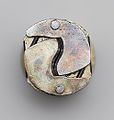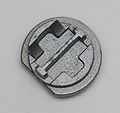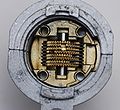Fichet 787: Difference between revisions
mNo edit summary |
m (category:france) |
||
| Line 85: | Line 85: | ||
[[Category:Lever locks]] | [[Category:Lever locks]] | ||
[[Category:Lock models]] | [[Category:Lock models]] | ||
[[Category:France]] | |||
Revision as of 09:50, 6 January 2023
Fichet 787
| Fichet 787 | |
 | |
| Name | Fichet 787 |
|---|---|
| Manufacturer | Fichet |
| Lock Type | Cylinder |
| Lock Design | Lever |
| Year(s) Produced | 1986 - Present |
| Patent | US 4,801,184 |
| Related Locks | |
| Fichet 480 Fichet F3D | |
The 787 is a lever lock made by Fichet. The 787 uses 8 or 10 levers and a series of gears that interface with a fence at the rear of the lock. In function, the 787 is a mix of lever, combination, and disc-detainer lock designs. The end result is a high-security lock mechanism that provides robust defense against many common attacks.
The 787 supercedes the older Fichet 480 design. Though still popular in France, it is slowly being replaced by the newer Fichet F3D design.
Principles of operation
The 787 uses a series of serrated levers that interface with gears and a fence. The gear stack is placed vertically at the back of the lock, held in place by a retaining rod. Each gear is separated by a washer to prevent adjacent gears from moving one another. Connected to each gear is a serrated lever that is also held in place by another retaining rod. There are 4 or 5 levers on each side of the core, and a separate spring mechanism on each side of the core. Downward pressure on the levers from the spring mechanism causes the gears to scramble when no key is inserted. The key has as many bitting cuts as there are levers, but only half of the cuts are used on each side. At the end of the bitting area is a reduced width section that interfaces wih the shutter, described below. There are 10 possible bitting depths, allowing ten billion (1010) differs in the ten lever version and 100 million (108) in the eight lever version.[1]
The insertion of the correct key moves each lever which in turn rotates each gear so that the true gates of each gear are aligned. The key is then pushed in further, allowing the inner core of the lock to move and pushes the gears into a fence mechanism. If all gears are aligned the fence will fall into the gears, allowing rotation of the core and movement of the cam. When the core is moved forward a blocking piece (Figure 26 in the patent diagram) is pushed up into the gear stack to prevent them from rotating further. This is an advanced manipulation resistance component that "freezes" each gear before it can meet the fence, similar in function to the Disc Blocking System used in the Abloy Protec.
At the front of the core is a spring loaded shutter responsible for keeping the internal components clean, ensuring proper operation of the lock, and providing a mild deterrent to manipulation. When the shutter is opened past a certain point it will block the forward movement of the core. The key itself has a reduced width section at the end of the bitting area which allows the shutter to close slightly once the key is fully inserted. This ensures the key is fully inserted before the core can be moved. The profile of the key tip and the reduced width section are varied based on the shutter design and actual keyway warding. The shutter also offers mild defense against manipulation because any tools used must allow the shutter to retract in order to push the core to the fence.
Model variations
- 787: Key bows are blocky (like a triangle with a round edge) with a pointed shutter mating section.
- 787 S: Eight lever model. Key bows are rounded with a pointed shutter mating section.
- 787 Z: Ten lever model. Key bows are rounded with a teardrop shutter mating section.
Disassembly instructions
The 787 is easy to disassemble and re-assemble in spite of the large number of components it uses.
- Remove the cam.
- Remove the core from the cylinder.
- Remove the small retaining rods from lever springs, then remove the lever springs.
- Remove the retaining rods from the levers and remove the levers.
- Remove the retaining rod from the gear stack and remove the gears and washers.
Notes
- A working key must be available in order to re-assemble the 787 correctly; insert the levers, lever springs, and their retaining rods first. Then, insert the working key to properly align the levers. Finally, insert each gear/washer so that the true gate of the gear is centered with the fence. The serrations between the lever/gear will hold each gear correctly in place using this method.
Vulnerabilities
The 787 may be vulnerable to one or more of the following:
Notes
- The mechanics of the cylinder make impressioning a very difficult attack.
- Falle Safe Securities produce a decoding tool for the 787.
Gallery
References
- ↑ PULFORD, Graham (2007). High Security Mechanical Locks: An Encyclopedic Reference. ISBN 0750684372.








